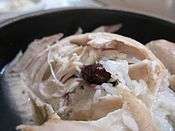Samgye-tang
.jpg) | |
| Alternative names | Ginseng chicken soup |
|---|---|
| Type | Tang |
| Place of origin | Korea |
| Serving temperature | Hot or Warm |
| Main ingredients | Chicken, ginseng |
| Ingredients generally used | Jujube, glutinous rice |
| Korean name | |
| Hangul | 삼계탕 |
|---|---|
| Hanja | 蔘鷄湯 |
| Revised Romanization | samgye-tang[1][2] |
| McCune–Reischauer | samgye-t'ang |
| IPA | [sam.ɡje̞.tʰaŋ] |
Samgye-tang (삼계탕; 蔘鷄湯) or ginseng chicken soup,[1] meaning ginseng (kor. sam) - chicken (kor. gye) - soup (kor. tang) in Korean, consists primarily of a whole young chicken (poussin) - filled with garlic, rice, jujube, and ginseng.[3]

Custom
Samgyetang is a warm soup for hot summer days. It is especially popular to eat this chicken soup on sambok (삼복) days, which are three distinct days of the lunar calendar—Chobok (초복), Jungbok (중복), and Malbok (말복)—commonly among the hottest and most sultry summer days in Korea.[3][4] Eating samgyetang on these days is believed to promote health.
Some specialty restaurants in South Korea serve nothing but samgyetang, having gained local popularity through their special recipes for the dish, which are often kept as secrets. The dish is sometimes accompanied by a small complimentary bottle of insam-ju (ginseng wine) in certain restaurants.[5][6]
Miscellaneous
In Cantonese, it is translated as yan sum gai tong. In Chinese culture, similar to Korean culture, this soup is believed to prevent illness. The one main difference is that in Chinese culture, ginseng is not consumed when one is sick because the ginseng is believed to trap the sickness within the person.[7]
Gallery
 Samgye-tang (closeup)
Samgye-tang (closeup) Samgyetang
Samgyetang Samgyetang
Samgyetang
 Ogolgye samgyetang
Ogolgye samgyetang
See also
| Wikimedia Commons has media related to Samgye-tang. |
References
- 1 2 (in Korean) "주요 한식명(200개) 로마자 표기 및 번역(영, 중, 일) 표준안" [Standardized Romanizations and Translations (English, Chinese, and Japanese) of (200) Major Korean Dishes] (PDF). National Institute of Korean Language. 2014-07-30. Retrieved 2017-02-16. Lay summary.
- ↑ "삼계탕". National Institute of Korean Language. Retrieved 2018-02-13.
- 1 2 Hyosun Ro. "Samgyetang (Ginseng Chicken Soup)". Korean Bapsang. Retrieved 2014-12-25.
- ↑ (in Korean) Boknal Archived 2011-06-10 at the Wayback Machine. at Encyclopedia of Korean Culture
- ↑ (in Korean) Taste, this taste, Sports Khan, 2009-06-08. Retrieved 2010-07-06.
- ↑ (in Korean) Nutritious foods of summer and wine, Maekyung, 2009-07-07.Retrieved 2010-07-06.
- ↑ Chan, Derek (January 14, 2012). "Samgyetang: Korean Ginseng Chicken Soup". Dining4two.blogspot.com. Retrieved 15 November 2014.
External links
- Kim Yeong-bok (김영복) / Yeo Gyeong-mo (여경모) (2007-07-12). "Samgyetang Story 1 (삼계탕 이야기 (상))" (in Korean). idomin.com.
- Kim Yeong-bok (김영복) / Yeo Gyeong-mo (여경모) (2007-07-26). "Samgyetang Story 2 (삼계탕 이야기 (하))" (in Korean). idomin.com.